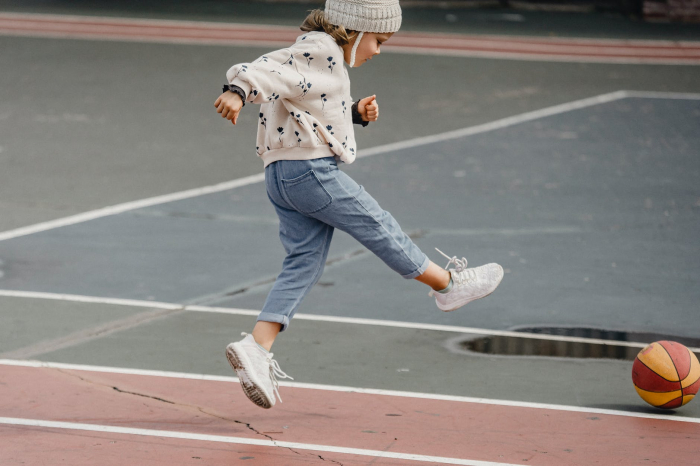0
Play is fun-damental to keeping a young child fit and healthy
Thursday 28th January, 2021

Exercise and movement help a child to develop muscles and strengthen bones. The heart is a muscle and just like the muscles in their legs that need to be strong for their first steps, the heart needs to be strong to keep them in the best possible cardiovascular health during their early years and beyond. Regular exercise helps to develop co-ordination and physical skills. This is just as true for older children as it is for non-mobile babies. A baby who can’t walk yet can still move their body and you can encourage them to develop gross and fine motor skills and build muscles by putting a toy just slightly out of reach or giving them a soft ball to try to hold, drop and throw, for example. Studies have shown that fitter children have better lung function, and children who have good levels of fitness during childhood have a greater lung capacity in adulthood. Lung health is something that a lot of us are thinking about right now with a pandemic that affects the respiratory tract.
Young children who are physically active tend to have good appetites as they have burnt off calories and energy, and need to replace that energy quickly. They also sleep better, which is an added benefit for parents!
There are so many benefits of exercise and movement for young children, but how can we make sure they stay active during this difficult time? Active play is one of the best ways to get young children moving and develop their physical skills and can happen anywhere. Our health and nutrition expert and former nursery manager, Vivette Eaton has suggested some wonderful inexpensive or free active play opportunities that work well at home or in the nursery.
You may even want to join in and try some of these yourself if you need a break from the living room workout!
Blowing bubbles or balloons
Age: 3 months+
Blow bubbles or bash balloons for child to chase, catch, try to keep in the air, etc. For babies, you can blow bubbles above them as they lie on their back or are sat down and encourage them to stretch out to touch them. For older children, you may wish to make the bubble mixture together as a science experiment.
Other skills developed: Observation, hand-eye coordination, stretching and balancing, controlled movements, texture, science
Traffic lights
Age group: Toddler and up
When I say ‘GREEN’ you need to move, when I say ‘AMBER’ you should slow down and when I say ‘RED’ you need to stop. You may want to specify an area that can use, like the hallway or an open space outside where they can stay a safe distance from others, and tell them that they need to stay where you can see them and they can hear you.
Green: Shake your body, spin, walk, jump, hop, skip, crawl, bottom shuffle, run, dance (dependent on space and physical ability)
Amber: Prepare to stop but don’t stop, just slow right down
Red: Stop completely still or sit down
Other skills developed: Following instructions, listening, body control, and balance
Sharks
Age group: Toddler and up
Continuously move around the room and when an adult or another child says ‘shark’ you need to get off the floor as quickly as possible (or out of the sea) by jumping on the mat, beanbag, cushion, coat, sofa, etc. Be sure to make sure there are lots of things a child can jump on in the room before starting the activity. You may wish to extend the activity by making a boat together with cardboard boxes.
Other skills developed: Imagination, problem solving, spatial awareness, following instructions, listening, body control, and balance
Scavenger hunt
Age group: Toddler and up
Give children a bag / basket / cardboard box / backpack and a list of items around the house or garden to find and bring back to you within a certain time limit. Depending on age and stage of development, you could use verbal instructions, pictures, or a written list. The items could be themed, so anything with a certain colour or shape or beginning with a letter of the alphabet.
Other skills developed: Communication, language, understanding time, observation, memory, shape or colour recognition, exploring their environment
Animal antics
Age: Toddler and up
Play music that gets children up and moving as different animals – fast music for a cheetah and a rabbit, slow stompy music for hippopotamus, and light airy music for birds, etc. Get children to pretend to walk or move like the animal in time to the music. You could also use flashcards with a picture of the animal on (you can ask the children to help you draw the animal as an arts and crafts activity before you play animal antics), or voice instruction.
Other skills developed: Thinking, applying, stretching, following instruction, listening, and understanding nature.
Where am I walking?
Age: 3 years+ (can be for younger children too if older children are playing with them)
Get children to show you using their movements where they might be walking – are they in mud, a swamp, water, autumn woodland leaves, sand, puddles, or on rocks or ice.
Other skills developed: Imagination, recall, following instructions, and listening skills.
Make a name (an outside game)
Age: 3-4+ (younger children with need a greater level of assistance)
Find leaves, twigs, or stones and use them to create your name on the ground.
Other skills developed: Observation, following instructions, appreciation of nature, texture, vocabulary, creative design
If you would like to learn more about the benefits of physical activity and suggestions for games and opportunities for play, you may be interested in our short course on Physical activity in the early years .